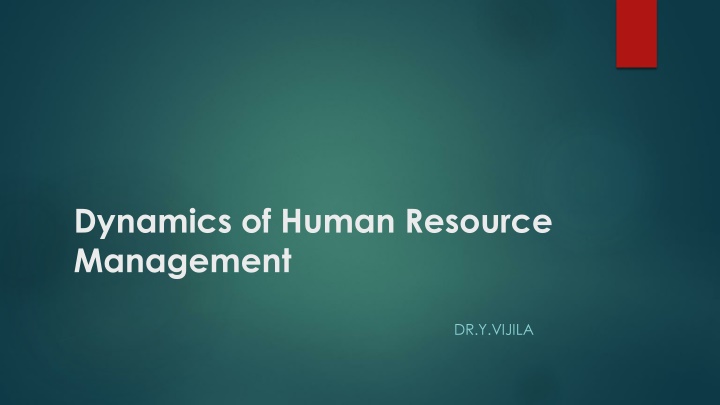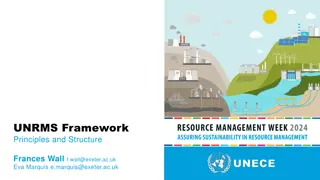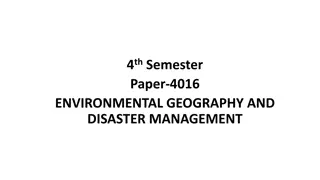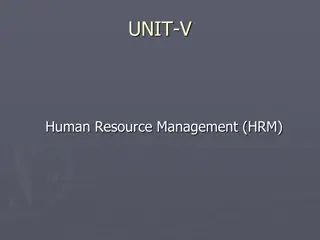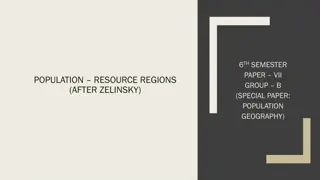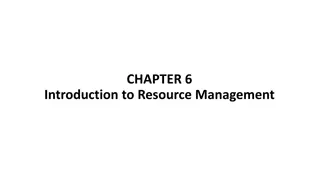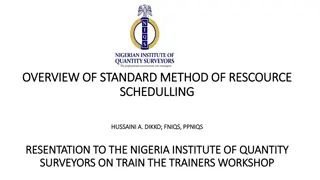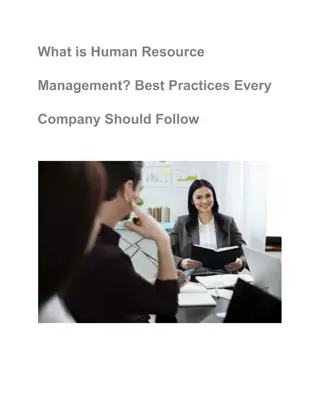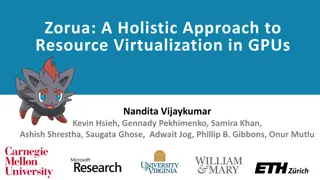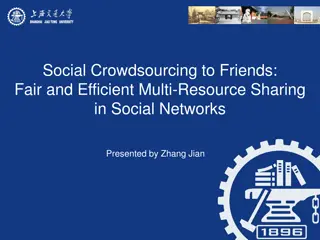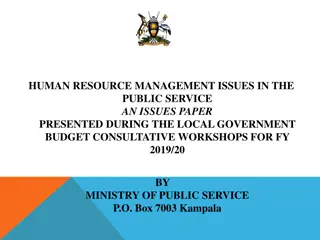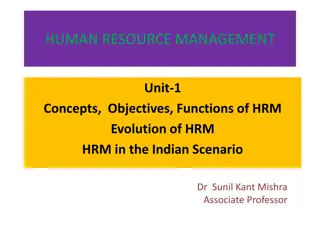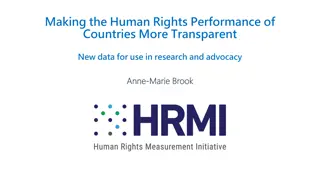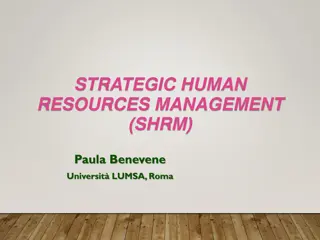Insights into Human Resource Management
The origins and growth of HR management, focusing on the importance of managing skilled workforce with respect and dignity. Learn about the evolution of HR practices from ancient times to modern organizations in India
Download Presentation

Please find below an Image/Link to download the presentation.
The content on the website is provided AS IS for your information and personal use only. It may not be sold, licensed, or shared on other websites without obtaining consent from the author.If you encounter any issues during the download, it is possible that the publisher has removed the file from their server.
You are allowed to download the files provided on this website for personal or commercial use, subject to the condition that they are used lawfully. All files are the property of their respective owners.
The content on the website is provided AS IS for your information and personal use only. It may not be sold, licensed, or shared on other websites without obtaining consent from the author.
E N D
Presentation Transcript
Dynamics of Human Resource Management DR.Y.VIJILA
Human: refer to the skilled workforce in the organisation. Resource: refer to limited availability or scarce. Management: refer to maximise or proper utilisation and make best use of limited and a scarce resource.
"you must treat your employees with respect and dignity because in the most automated factory in the world, you need the power of human mind. That is what brings in innovation. If you want high quality minds to work for you, then you must protect the respect and dignity. " -Mr N.R. Narayana Murthy, Chairman Emeritus, Infosys Ltd >>.
The human mind is our fundamental resource. - John F. Kennedy.
Human Resource Management HRM is the process of managing people in organizations in a structured and thorough manner. HRM encompasses the management of people in organizations from a macro perspective.
Origin and growth of HR function in india
ORIGIN OF HR Its origin is dated back to 1800 BC., when wage and incentive plans were included in the Babylonian code of Hammurabi. The world s first management book, titled Artasastra written by Kautilya, in 400 BC, codified many aspects of human resource practices in ancient India.
GROWTH OF HUMAN RESOURCE HRM in India could be traced back to the period after 1920, when emphasizes was on worker welfare. In 1931, the royal commission on labor suggested the appointment of labor officer to protect workers interests . Appointment of labor officer
The second world war Enactment of Industrial dispute Act Enactment of Factories Act 1960 and after ..
FIRST PHASE Immediately after independence the focus was on four reasons : Maintain discipline Prevent their formation of and break-up the leadership of trade unionism. Prevent their formation of and break-up the leadership of trade unionism Handle recruitment and termination Keep some form of attendance and personnel records.
SECOND PHASE IN 1960S, Indian industrialization got a fillip with the rise of the public sector. Hence 3 more functions were added i.e., Labor welfare Participative management Industrial Harmony In this period, the human relations movement of the west also had its impact on Indian organization.
THIRD PHASE In 1970, the people management functions was neatly divided into two : Personnel officer Establishment officers
Fourth Phase In 1976, birth of worker training institute and attitudinal development.
Fifth Phase In 1985, organization shifted towards making HR Department separately. HRD and personnel function were clubbed together.
Sixth phase In early 1990s : HRM was seen as strategy Motivation and stress were considered to bring change in HRM Focus on organization objectives
Seventh Phase In the mid of 1990s, sub specialization like : Industrial Relations Training & Development Information system
Eight phase HRM is not selective management any more It became the part of Corporate Strategy formulation and strategy implementation team
Later Arrival of HRM in India Late arrival of factory system Low status of industrial worker Professionalization of Human resource Management Social responsibilities of Business Change of government attitude
Factors Impending the growth of HRM in India Abundance of cheap labor Weak labor movement Highly Authoritarian culture Technological Backwardness Instability in Employment Unhealthy growth of Trade unions Migratory characteristic of Indian labor
Evolving Role of HRM in India Origin Of Human Resource Management in India The Welfare Man The law Man The Liaison Man The HR Man
David Guest [1987-89] :Haward University [1] Strategic integration [Oriented to Mgnt] [2] High Commitment [Oriented to Employee] High Quality [Oriented to Product] Flexibility [Oriented to Orgn] [3] [4]
Karen Legge [1989/UK] A Course Team Leader for Sociology at Long Road Sixth Form College, Cambridge, UK. She considers that one of the common themes of the typical definitions of HRM is that HR policies should be integrated with strategic business planning.
HRs should be tapped most effectively by mutually consistent policies that promote commitment and which, as a result, foster a willingness in employee to act flexibly in the interest of the orgn s pursuit of excellence.
John Purcell:-Strategic Academic Adviser, ACAS, and Research Professor at Warwick University, UK. / Adoption of HRM is both product of & a cause of a significant concentration of power in the hands of Mgnt. To achieve strategic plan of orgn, Mgnt exercises some power. / HRM Mngr indirectly uses this power
Emerging Challenges in HRM:- 1. Merger and Acquisition : 2.Changing workforce profile:- 3.Newer Organizational Design 4. Increasing Quality Consciousness
RESERVATIONS ABOUT HRM HRM promises more than it delivers and that its morality is suspect. Guest (1991) believes that HRM is an optimistic but ambiguous concept ; it is all hype and hope.
Contradictions in the reservations about HRM The first as formulated by Legge (1995, 1998) is that, while management rhetoric may express concern for workers, the reality is harsher.
He considers that HRM policies & practices include compensation, culture of reward, team work, harmonization, quality all the activities related to HRM.
